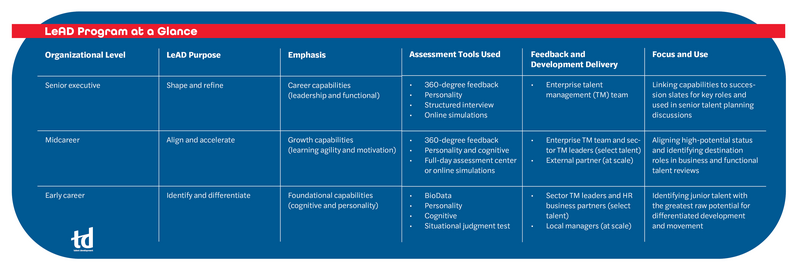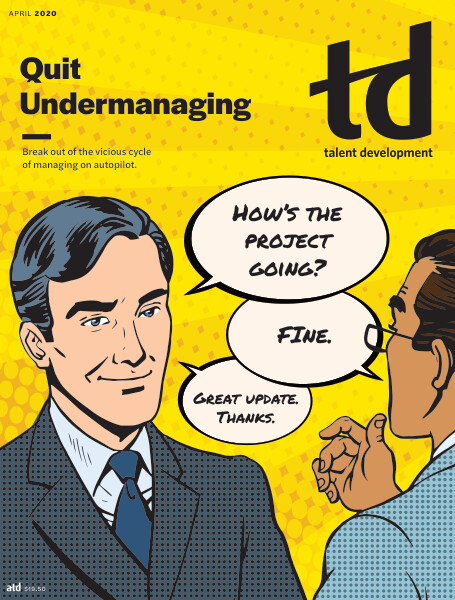TD Magazine Article
PepsiCo's Formula for Leadership Potential
The food and beverage company PepsiCo uses research-based strategiesstrategies—rather than managers’ perceptions—to identify high potentials.
Wed Apr 01 2020

Bookmark
The food and beverage company uses research-based strategies—rather than managers' perceptions—to identify high potentials.
When it comes to planning and managing talent for an organization's future, potential is one of the most enduring topics. Benchmark studies indicate upward of 70 percent of companies are currently assessing and developing their high potentials and senior leaders, and another 10-15 percent are in the process of building a system to do so. Many organizations rely on performance ratings to make determinations on high potentials, but research consistently shows that past performance is not a great indicator of future potential.
The elusiveness of potential also makes it one of the most perplexing issues to solve for: What exactly is potential? How do we measure it? How do we ensure we maximize it when and if we do find it? Clearly, the answer "I know it when I see it" is neither a defensible investment (or selection) strategy nor the best way to manage talent for the future.
PepsiCo, a global food and beverage organization with $22 billion iconic brands, faced a similar dilemma. As such, the enterprise talent management center of expertise (TM COE) embarked on a journey to develop a comprehensive strategy to identify and measure potential via an integrated high-potential assessment and development system. The result is the LeAD (Leadership Assessment & Development) program, which has been fully operational for seven years. LeAD comprises a suite of psychological and behavioral assessment tools leveraging both technology and high-touch feedback delivery by the TM COE team.
LeAD's impact is evident by the strength of PepsiCo's leadership pipeline, the data-driven approach to executives' and managers' people discussions, and the company's robust culture of feedback and development. Perhaps the most compelling indicator of program success, however, is the overwhelming level of engagement and support it has from the business. While LeAD's design and management is centrally funded, the business sectors and global functions pay the individual participant costs for assessment and deliver customized development planning for leaders who go through it. To date, more than 10,000 employees across all levels and nearly all senior leaders have been assessed at some stage in their careers. Both the volume of assessments administered and the degree to which the business invests time in development efforts leveraging LeAD data demonstrate how strongly the program is embraced.
Defining leadership potential
PepsiCo has focused on moving beyond using performance to measure and identify potential, because it is often a judgment call managers and HR professionals make and reflects what makes someone successful today, not what will make that individual successful for the future. LeAD employs a more nuanced framework, looking to foundational, growth, and career dimensions when considering someone's potential:
Foundational dimensions are the basic building blocks of potential. They include cognitive skills (for example, strategic thinking, connecting the dots, and analytics and insights) and personality characteristics (such as social and interpersonal skills, curiosity and creativity, and the ability to moderate derailers). While not easy to change, the foundational dimensions are easy to measure using a variety of tools organizations already have.
Growth dimensions are characteristics that facilitate or enhance an individual's ability to be successful in new roles, situations, and environments. They include learning agility and motivation. If someone at PepsiCo can't learn or isn't motivated to do so, leaders question the individual's status as a true high potential. Growth dimensions are often stable over time, but they do change and can be developed or influenced via tools, coaching, training, and career conversations.
Career dimensions are the leadership capabilities and functional expertise a person needs to be successful in a given organizational context. PepsiCo considers both critical leadership skills (such as inspiring others, collaboration, ethics, and integrity) as well as specific behaviors and new capabilities that will drive business growth in the future (such as digital fluency and analytics). Career dimensions are the easiest to measure through tools such as 360-degree feedback and competency frameworks and can be developed via experiences, coaching, mentoring, formal leadership programs, and online learning.
The three dimensions are based on the Leadership Potential BluePrint model, which underlies all the predictive work PepsiCo has done with respect to assessing and developing future leaders. The model, which Rob Silzer and Allan Church developed, is grounded in 50 years of academic theory, research, and practice. It is easily adaptable to integrate the latest trends in the field such as learning agility, curiosity, and digital leadership.
To properly measure the dimensions, PepsiCo uses a multi-trait, multi-method approach to produce an assessment index that classifies individuals into one of four ranges. Although an individual does not need high assessment scores to be classified as a high potential or ascend to more senior roles, this framework enables the company to be fully cognizant of each leader's strengths and limitations that could affect future success.
The assessment index is fully transparent to employees, and internal data has shown that employees strongly prefer to know the outcome of the measurement process and predictive algorithm rather than be kept in the dark as to how they did overall. In fact, TM COE research shows no negative impact on engagement or turnover for any talent pool participating in LeAD as a result of this level of transparency (see sidebar).
Assessing talent across the leadership pipeline
Leadership competencies should be the language of potential and how individuals, managers, and senior leaders talk about talent in a pipeline and succession context. Thus, the LeAD program is embedded within a user-friendly and digestible competency framework called the PepsiCo GREAT5, which succinctly describes what it takes to go from being a good to great leader and is the basis for the organization's leadership development programs and talent management practices.
Growth reflects a person's curiosity and ability to learn from novel situations by constantly pushing outside their comfort zone and helping others to learn and develop.
Relationships involves building and maintaining trusting relationships across organizational boundaries by modeling integrity, transparency, and authenticity and being respectful and inclusive of others.
Execution is the energy, enthusiasm, and inspiration an individual brings to motivate others to action and to accomplish ambitious goals, and it is simplifying complexity to drive quality results.
Agility involves adapting a person's style and approach to an ever-changing business environment, managing pressure, and embracing and championing change to drive transformation.
Thinking reflects how an employee brings in and uses external insights (business, customer or consumer, industry, global), thinks creatively, and takes a long-term and holistic perspective to make informed decisions.
LeAD employs different tools such as 360-degree feedback, cognitive tests, personality measures, and customized business simulations to measure the GREAT5 as well as the associated behaviors. Using a tiered approach based on leadership transitions, the assessment and development work emphasizes different aspects of the GREAT5 at different levels of potential in the organization. At junior levels, foundational capabilities reign; at senior levels, possessing specific role capabilities becomes more important. The LeAD Program at a Glance figure provides an overview of the tools and development focus at each level.
By deploying different tools at different levels within the same overall GREAT5 framework, PepsiCo gets the best of both worlds: unique yet complementary insights on a consistent behavioral model with developmental focus areas and a predictive outcome of future success.
Preparing the talent management team
While it is critical that organizations use well-grounded and empirically validated tools to measure leadership potential, it is equally important to ensure that the right level of capability exists among talent management and HR professionals to effectively deliver the results to participants in a meaningful way. Internal research has shown that the more positive LeAD participants are about the feedback and development sessions they have, the more likely they are to demonstrate behavior change 12-18 months later. To that end, LeAD uses highly trained specialists in industrial-organizational psychology in the enterprise TM COE to deliver the feedback and development-planning discussions at the senior most levels in one-on-one sessions.
Augmenting this process is internal certification training for organization development, talent management, and HR professionals in the business sectors to ensure they have the requisite skills needed to interpret the results and help their local leaders make the most of the assessment insights for their development. In addition, external assessment feedback partners are leveraged where capability or the capacity of internal resources are needed.
In fact, one of LeAD's hallmarks (and one for which participants consistently provide positive feedback) is that the results and development-planning efforts are individualized for each leader. Although resource-intensive, this approach ensures that participants and the organization obtain the maximum benefit possible from the insights generated for building future capability.
Developing future leaders via the 70-20-10 framework
Working with a future-back mindset—starting with the career destination role in mind and working backward to build an experiential development plan—the talent management team uses results from LeAD and talent reviews to offer developmental opportunities in all three areas to help shape, refine, align, and accelerate future leaders. What follows is the approach the team used for high potentials in particular.
Careers as a sequence of critical experiences (70 percent). When it comes to developing high potentials, the TM COE team works closely with the senior line and HR leadership to maximize the mix of experiences across three important company landscapes: functional, leadership, and broadening critical experiences.
A comprehensive approach to coaching (20 percent). Coaching implementation aligns with the overall talent strategy, and a central enterprise infrastructure manages quality, consistency, evaluation, and overall rigor. An internal cadre of seasoned and certified coaches debrief assessment results and support the creation of tailored development plans. In addition, integrated into the PepsiCo University curriculum are coaching skills for managers, and the company offers advanced coaching as part of targeted key transitions (for example, new senior executive integration efforts).
Corporate university as the bedrock of formal learning (10 percent). PepsiCo University encompasses more than 15,000 active learning assets and 1 million program completions yearly. The curriculum was custom designed to develop leadership and functional skills for future success. At the functional level and in the context of critical skills needed for succession there, all major functional areas (for example, finance and HR) offer programs that build capabilities and competencies.

Success indicators
The company is committed to ensuring that leaders with potential advance and succeed at higher levels via internal development efforts, and LeAD delivers. The leading measures and outcomes the TM COE team has tracked over time include:
Performance. Those who do better on LeAD deliver stronger sustained performance using three-year average performance ratings after program completion.
Promotion. Those who do better in LeAD and successfully improve against their development objectives are promoted at 1.5 to 2.5 times faster rates than those who do not. Interestingly, anyone who participates in the program has a higher likelihood of promotion versus those who opt out, countering a common misperception that being assessed is inherently a bad thing.
Engagement. All LeAD participants indicated high engagement and felt supported by the organization (between 82 percent and 92 percent depending on the program). They also have significantly more career clarity.
Turnover. No significant differences in turnover exist for LeAD participants regardless of their assessment performance. The fear that high potentials will feel anointed and leave sooner was not realized nor was there an exodus of the traditionally labeled "B players."
Potential. Those who performed better on LeAD were three times more likely to have their potential status re-evaluated during talent discussions than those without assessment data. Thus, the stigma of not being a high potential becomes less relevant when predictive data is available.
Behavior change. Participants who execute against their development plans are more likely to show improvements in their leadership behaviors on a 360-degree survey as rated by their managers, peers, and direct reports within 12-18 months.
The search for potential is a challenging one that requires discipline in not letting the "I know a high potential when I see one" mentality win the day. PepsiCo's LeAD program shows that it is possible to make a meaningful difference in the quality, engagement, and performance of the best and brightest by using a fully integrated and validated assessment and development approach grounded in theory rather than perception.
The Path to Transparency
In terms of high-potential programs, transparency is a key value, yet many companies don't deliver. Benchmark data indicates that 66 percent of large companies have a policy not to share high-potential status with employees. When probed further, 33 percent said employees figure out their status through senior leadership actions (for example, invitations to a program, special assignments, and additional financial incentives), and another 18 percent said managers simply tell their people anyway. So, why all the fuss over being transparent? Typically, concerns include feelings of entitlement among those told they are a high potential, higher probability of turnover of top performers told they are not a high potential, and decreased engagement concerns in general.
As part of PepsiCo's LeAD (Leadership Assessment & Development) program, the talent management center of expertise has tested these concerns using an assessment index as a proxy for high-potential status. The talent management team collected data from program participants immediately after assessment results were delivered as well as six to 18 months later. Results suggest transparency can work if you are clear about what you are telling people and why. Specifically, no relationships were found between participants' index scores and their attitudes toward LeAD or PepsiCo.
All participants were positive, with 84 percent or more saying the program met their expectations and gave them a real opportunity to improve their skills. There were also no differences in turnover, regardless of their index. The only attitudinal difference identified was whether participants felt the report accurately described them. Those who didn't do as well as others were less likely to agree that the report "felt like me," but their scores did not negatively influence their broader level of engagement or feelings about the program and the organization's level of commitment to development.


